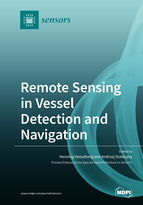Remote Sensing in Vessel Detection and Navigation
A special issue of Sensors (ISSN 1424-8220). This special issue belongs to the section "Remote Sensors".
Deadline for manuscript submissions: closed (30 June 2020) | Viewed by 56326
Special Issue Editors
Interests: satellite surveillance, multispectral imaging, SAR imaging, ship and iceberg classification, machine learning
Interests: radar navigation; comparative (terrain-based) navigation; multi-sensor data fusion; radar and sonar target tracking; sonar imaging and understanding; MBES bathymetry; ASV; artificial neural networks; geoinformatics
Special Issues, Collections and Topics in MDPI journals
Special Issue Information
Dear Colleagues,
Earth observation by multispectral, SAR, and other sensors provides unique gobal as well as detailed local surveillance. Resolutions allow for vessel detection, classification, and discrimination from, e.g., icebergs and other objects. Important applications include vessel detection and navigation; trafficing and safety; and monitoring the oceans for fishing, oil slicks, territorial violations, piracy, refugee boats, etc. With global warming, the north-east and -west passages have opened up for shipping, fishing, and cruise ships in uncharted reef-infested territories littered with sea-ice and titanic icebergs.
In this Special Issue of Sensors, we will collect articles covering many aspects of multispectral, multi-sensor, SAR, and other sensors related to science/research, algorithm/technical development, analysis tools, synergy with sensors in multiple wavelengths of the e.m. spectrum, synergy with other measurements such as AIS, as well as reviews of the state-of-the-art in ocean processes using multispectral and SAR imagery for oceans and sea ice, and vessel monitoring for surveillance, trafficking, and navigation. Topics for this Special Issue include but are not limited to the following:
- Vessel detection, classification, and identification;
- Sea-ice and iceberg detection and tracking;
- Multi-sensor data fusion;
- Autonomous ships navigation;
- Comparative (terrain reference) navigation;
- Change detection for classifying islands, reefs, and other static objects;
- Synergy with and comparison to AIS and other vessel identification data;
- Synergies between satellite sensors with airborne platforms; multiple satellite SAR; optical and thermal infrared sensors including finer resolution sensors, for example, sentinels and other satellites, and in situ measurements;
- The use of multispectral, multiple frequencies, and polarizations to interpret and quantitatively assess various ocean surfaces, currents, and sea ice phenomena for navigation;
- Interferometric and Doppler-derived SAR oceanic and sea ice applications focused on surface motion;
- Validation studies for vessel, ocean, and sea-ice parameters based on in situ and airborne data collections;
- Use of machine learning and the build-up of annotated training databases;
- Artificial Intelligence for image data processing.
Dr. Henning Heiselberg
Prof. Dr. Andrzej Stateczny
Guest Editors
Manuscript Submission Information
Manuscripts should be submitted online at www.mdpi.com by registering and logging in to this website. Once you are registered, click here to go to the submission form. Manuscripts can be submitted until the deadline. All submissions that pass pre-check are peer-reviewed. Accepted papers will be published continuously in the journal (as soon as accepted) and will be listed together on the special issue website. Research articles, review articles as well as short communications are invited. For planned papers, a title and short abstract (about 100 words) can be sent to the Editorial Office for announcement on this website.
Submitted manuscripts should not have been published previously, nor be under consideration for publication elsewhere (except conference proceedings papers). All manuscripts are thoroughly refereed through a single-blind peer-review process. A guide for authors and other relevant information for submission of manuscripts is available on the Instructions for Authors page. Sensors is an international peer-reviewed open access semimonthly journal published by MDPI.
Please visit the Instructions for Authors page before submitting a manuscript. The Article Processing Charge (APC) for publication in this open access journal is 2600 CHF (Swiss Francs). Submitted papers should be well formatted and use good English. Authors may use MDPI's English editing service prior to publication or during author revisions.








